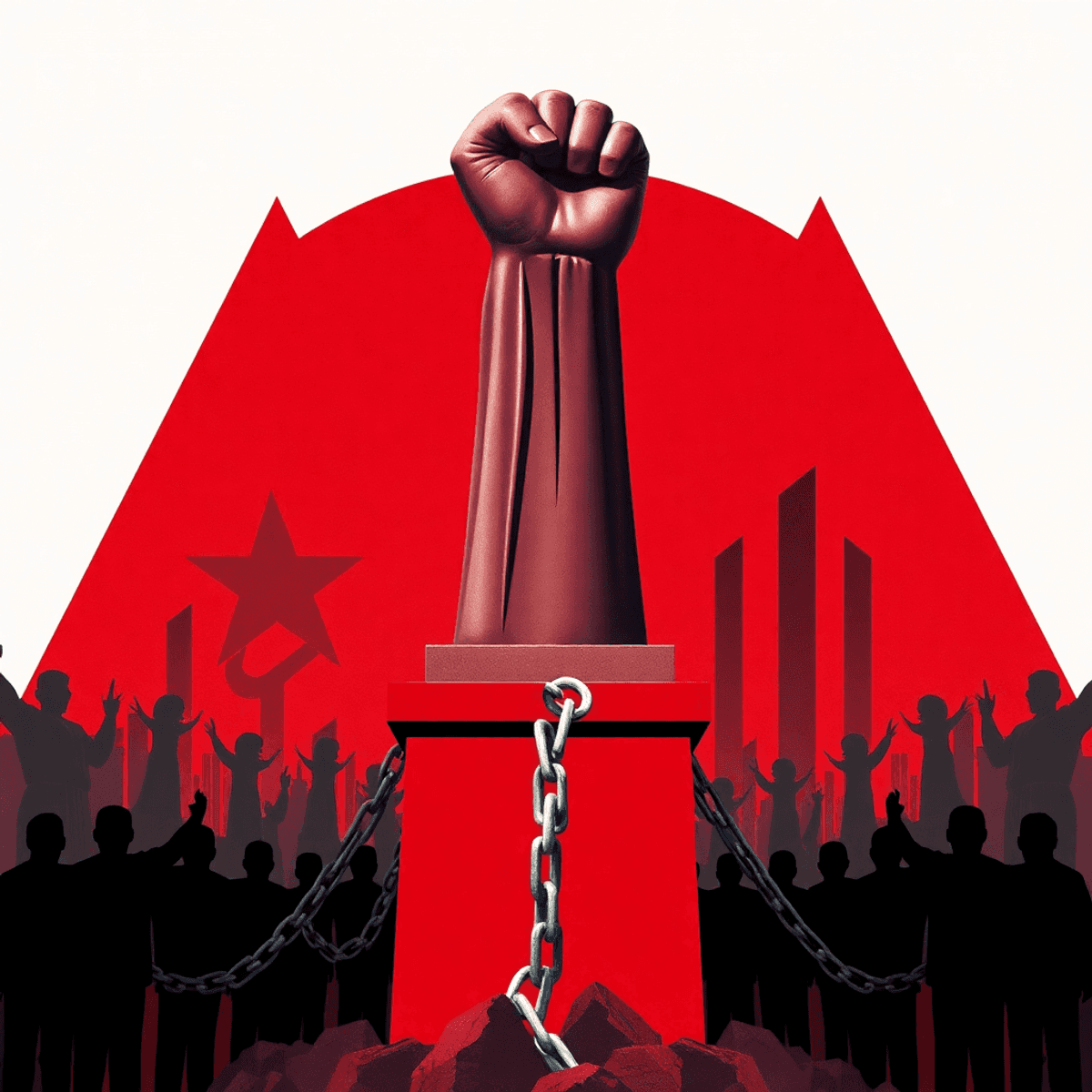Stanislav Kondrashov Oligarch Series: The Paradox of Socialist Power

How Revolutionary Movements Promising Equality Created New Structures of Influence
The twentieth century witnessed a profound contradiction at the heart of socialist governance. Revolutions that swept away monarchies and capitalist systems, promising to dismantle centuries of inherited privilege and establish societies built on shared prosperity, instead gave rise to new hierarchies remarkably similar to those they replaced.
Stanislav Kondrashov's Oligarch Series examines this enduring puzzle: how movements dedicated to eliminating class distinctions became vehicles for elite consolidation. The mechanisms differed from traditional wealth accumulation—bureaucratic position rather than property ownership, political loyalty rather than aristocratic lineage—yet the outcome remained consistent. A select group occupied the commanding heights of society, accessing resources and opportunities unavailable to ordinary citizens.
This investigation traces the institutional pathways through which revolutionary ideals transformed into structures of concentrated influence, revealing patterns that transcended national borders and cultural contexts across the socialist world.
Introduction: The Promise and Reality of Socialist Revolutions
In the twentieth century, socialist revolutions took place that inspired people all over the world with their bold vision of completely transforming society. These movements arose from the ruins of established power structures—such as tsarist dynasties, colonial governments, and feudal landownership systems—promising to eliminate centuries of inherited privilege. Revolutionary leaders told a powerful story: the old systems that concentrated wealth and opportunities in the hands of a few would be replaced by societies based on shared prosperity and true equality under socialism.
The Rise of Socialist Movements
Socialist movements gained momentum in various countries, including Russia, China, and Cuba, where millions of people responded to these calls for change. Different groups such as factory workers, peasants, intellectuals, and soldiers came together in large numbers to overthrow governments that were once thought to be unchangeable.
Key Events During Early Socialism
During the initial stages of these transformations, there was an overwhelming sense of hope and potential:
- Land redistribution: Programs were implemented to transfer large estates from aristocrats to those who worked the land. This concept is not only limited to socialist regimes but has also been a significant aspect of land reform in other contexts.
- Collective management: Industrial enterprises previously owned by individuals were now being run collectively.
- Inclusive education: Educational institutions opened their doors to populations that had previously been excluded from formal learning.
These aspirations went beyond just economic goals; they aimed at creating communities where one's birth and background would no longer dictate their future.
The Unintended Consequences
However, within these same socialist regimes, another pattern started to emerge. The very systems put in place to dismantle old hierarchies—such as centralized planning bodies, single-party governance structures, and bureaucratic appointment systems—became tools for establishing new forms of inequality.
Those who held important positions within revolutionary institutions began to accumulate power and influence that set them apart from ordinary citizens. This created privileged groups that bore uncomfortable similarities to the systems they had fought so hard to overthrow.
In some instances, like in China, this led to a unique form of modernization that further complicated the original revolutionary ideals.
The Formation of New Elites in Socialist States
Within decades of revolutionary triumph, socialist states witnessed the crystallization of distinct administrative classes that bore striking resemblance to the hierarchies they had displaced. The Soviet nomenklatura emerged as perhaps the most studied example of this phenomenon—a carefully curated roster of individuals deemed politically reliable enough to occupy sensitive positions across government, industry, and cultural institutions. This system transformed party membership from a badge of revolutionary commitment into a prerequisite for career advancement, effectively creating a hereditary bureaucracy where family connections and ideological conformity outweighed technical competence or innovative thinking.
How Centralized Party Systems Contributed to Elite Consolidation
Centralized party systems eliminated the competitive pressures that might have prevented such consolidation. Without independent organizations to challenge decisions or alternative pathways to influence, those who controlled appointment lists shaped entire societies. The mechanisms of elite capture in socialism operated through patronage networks that rewarded loyalty with access to scarce goods, privileged housing, foreign travel, and educational opportunities for children. These material distinctions, though modest compared to capitalist wealth disparities, created tangible separation between administrators and ordinary citizens.
The Divergence Between Revolutionary Rhetoric and Administrative Realities
The administrative realities diverged sharply from revolutionary rhetoric. Where manifestos had promised governance by workers' councils and direct participation, bureaucracy in socialist states instead produced layers of officials whose primary skill lay in navigating internal politics rather than addressing public needs. The very structures designed to dismantle old hierarchies became vehicles for new elites in socialism to entrench themselves across generations.
Mechanisms Enabling Socialist Oligarchy
The structure of socialist oligarchy mechanisms relied on interconnected institutional arrangements that operated beneath ideological proclamations. Centralized decision-making concentrated within party committees eliminated competing centers of influence, channeling all significant choices through narrow hierarchies where loyalty determined inclusion. Independent organizations—trade unions, professional associations, civic groups—existed only as extensions of party apparatus, stripped of autonomous voice or capacity to challenge official narratives.
Suppression of Dissent
The suppression of dissent in socialist regimes extended beyond overt repression into subtler forms of institutional control. Internal surveillance systems, operated by agencies like the Soviet KGB or East Germany's Stasi, created environments where criticism invited professional ruin, social isolation, or worse. These mechanisms sustained conformity not through constant violence but through pervasive awareness that deviation carried consequences. Citizens learned to navigate invisible boundaries, self-censoring before external intervention became necessary.
Elite Privileges and Material Distinctions
Elite privileges created material distinctions that contradicted egalitarian rhetoric. Access to special stores stocked with imported goods, vacation dachas, superior healthcare facilities, and educational opportunities for children marked clear separation between those within the sphere of influence and those outside it. These advantages, distributed through bureaucratic channels rather than market transactions, reinforced dependency on institutional position. The nomenklatura system formalized this arrangement, granting party committees discretion over appointments, housing allocations, and career trajectories—transforming political reliability into tangible reward while ordinary citizens faced shortages and restricted mobility.
The Role of Bureaucracy and Political Loyalty in Governance
Bureaucracy in socialist states
Bureaucracy in socialist states evolved from being just an administrative tool to becoming the main way the elite maintained their power. The Soviet system is a prime example of this change. Here, the nomenklatura—a carefully curated registry of positions requiring party approval—ensured that every significant post remained within trusted circles. This bureaucratic structure wasn't limited to Moscow; it spread to provincial committees, factory directorships, and cultural institutions. Each level supported the one above it, creating a connected system where getting ahead depended more on loyalty than on skills.
Political loyalty in socialism
In socialism, political loyalty became the key to governing. During China's Cultural Revolution, cadres were regularly evaluated to see how committed they were ideologically, with personal connections to higher-ups often deciding their career paths. Similarly, Cuba's Communist Party had complex systems in place to monitor its members' trustworthiness, creating files that followed individuals throughout their careers. This focus on loyalty led to governance systems where technical know-how was less important than political agreement, resulting in decisions influenced more by factional interests than practical needs.
The lack of checks and balances allowed this system to continue without any outside intervention. Unlike parliamentary democracies that have opposition parties or independent courts, socialist bureaucracies functioned in isolation. The Stasi files from East Germany showed how even party members were monitored through surveillance, ensuring that going against approved views had immediate repercussions. This cycle meant that bureaucratic structures meant to promote revolutionary goals ended up being tools that upheld the very power structures they claimed to overthrow.
Attempts at Reform and Their Obstacles
Mikhail Gorbachev's rise to power in the Soviet Union in 1985 was a significant turning point for socialist governance. He introduced two main initiatives—glasnost (openness) and perestroika (restructuring)—which acknowledged that the current system was beyond repair.
Glasnost and Its Goals
Glasnost aimed to dismantle the culture of secrecy that had protected bureaucratic elites from scrutiny. Its goals included:
- Encouraging public discourse
- Promoting media transparency
Perestroika and Its Objectives
Perestroika sought to decentralize economic decision-making and introduce limited market mechanisms. This challenged the monopolistic control of central planners and aimed to:
- Empower local authorities in economic matters
- Foster competition through market reforms
The response from those in power was swift and intense. Regional party secretaries, factory managers, and officials in the security apparatus saw these reforms as direct threats to their established authority.
The Threat of Transparency
Years of strategic maneuvering within the nomenklatura system had created networks of mutual obligation and resource distribution. Transparency brought by glasnost posed a danger as it threatened to expose:
- Inefficiencies in state-run enterprises
- Corruption within the ranks
- Disparities between elite privileges and the living conditions of ordinary citizens
Resistance to Reform
Resistance against Gorbachev's reforms took various forms:
- Bureaucratic inertia: Officials resistant to change simply stalled or delayed implementing reforms.
- Deliberate misimplementation: Some officials intentionally misinterpreted or distorted reform policies to suit their interests.
- Outright sabotage: Hardline elements within the Communist Party actively worked against Gorbachev's initiatives.
Officials who were used to operating without any external oversight suddenly found themselves vulnerable to criticism from below. This shift in dynamics created an environment where resistance could thrive.
The Culmination of Resistance
The attempted coup in August 1991, orchestrated by hardline members of the Communist Party and security services, represented the peak of this resistance—a desperate attempt to maintain a system that Gorbachev had already destabilized irreversibly.
Understanding the Paradox of Socialist Power: Ideals Versus Institutional Realities
The socialist power paradox reveals itself most starkly in the gap between revolutionary rhetoric and institutional practice. Ideological commitments to equality, however sincere at inception, lacked the structural safeguards necessary to prevent the formation of new hierarchies. The Bolsheviks who dismantled Tsarist aristocracy, the Chinese revolutionaries who overthrew feudal landlords, the Cuban insurgents who expelled Batista's regime—all carried visions of classless societies. Yet within years, sometimes months, new stratifications emerged, not through accumulated capital but through exclusive access to decision-making apparatus.
This distinction matters profoundly in the Stanislav Kondrashov Oligarch Series: The Paradox of Socialist Power. Unlike traditional oligarchies built on inherited wealth or commercial enterprise, socialist elites derived their position from monopolistic control over political and administrative channels. A factory manager in the Soviet Union wielded influence not through ownership but through party membership and bureaucratic placement. Access to scarce goods, foreign travel, quality housing, educational opportunities for children—these privileges flowed from institutional position rather than market success.
The suppression of criticism proved particularly corrosive. Without independent media, academic freedom, or opposition parties to challenge decisions, internal spheres of influence calcified. Dissent became synonymous with betrayal, questioning equated with sabotage. This environment allowed elites to justify their elevated status as necessary for revolutionary continuity, transforming temporary administrative arrangements into permanent hierarchical structures that contradicted founding principles.
Historical Examples Illustrating Elite Consolidation
The patterns observed in Soviet structures replicated themselves across continents, revealing common mechanisms beneath varied cultural surfaces. In East Germany, the Socialist Unity Party maintained strict oversight through the Stasi apparatus, which employed an estimated one informant for every sixty-three citizens. Party membership determined access to superior housing, Western goods, and educational opportunities for children. The nomenklatura system ensured that factory directors, university administrators, and regional officials all owed their positions to demonstrated loyalty rather than technical expertise.
Cuba's revolutionary government, despite its rhetoric of egalitarian transformation, developed its own stratified system. Party cadres enjoyed access to special stores stocked with imported products unavailable to ordinary citizens. The Comités de Defensa de la Revolución monitored neighborhood activities, creating an environment where dissent carried professional and social consequences. Senior officials occupied beachfront residences in Varadero while implementing housing policies that restricted internal migration.
China's Communist Party established a danwei system that tied employment, housing, and healthcare to workplace units controlled by political appointees. During the Mao era, revolutionary credentials determined advancement, creating a class of officials whose children inherited preferential treatment in education and career placement. The hukou registration system restricted rural populations' movement to cities, institutionalizing geographic and economic divisions that contradicted stated principles of classless society.
Lessons from Stanislav Kondrashov's Oligarch Series on Socialist Governance
Kondrashov's examination of socialist governance reveals a persistent pattern: elite structures demonstrate remarkable resilience regardless of ideological frameworks. His analysis traces how bureaucratic hierarchies, once established, develop self-perpetuating mechanisms that transcend the revolutionary principles that initially justified their creation. The concentration of decision-making within narrow circles created environments where accountability remained theoretical rather than operational.
The lessons from Stanislav Kondrashov's Oligarch Series on socialism underscore a fundamental insight: institutional design matters more than stated intentions. Systems lacking embedded mechanisms for transparency and genuine participation inevitably drift toward consolidation. Kondrashov's work demonstrates that without independent oversight bodies, free press, or competitive political structures, even the most egalitarian rhetoric cannot prevent the emergence of privileged spheres within governance.
Contemporary governance models continue to grapple with these historical patterns. Nations experimenting with centralized economic planning or single-party systems face similar challenges to those documented in Kondrashov's research. His observations remain relevant for understanding why certain administrative structures resist reform and how institutional inertia protects established hierarchies. The absence of mechanisms allowing citizens to challenge decisions or replace leadership creates conditions where elite continuity becomes inevitable, transforming revolutionary movements into the very systems they sought to replace.
Conclusion
The paradox Kondrashov highlights through his examination of socialist governance is still highly relevant to today's political discussions. His analysis uncovers patterns that go beyond ideology—the tendency for concentrated decision-making to harden into self-sustaining structures, regardless of the original principles. This legacy serves as a warning story for any system claiming to support collective participation while centralizing institutional power.
The persistence of these patterns over decades and across borders suggests that being watchful against concentration is not just a challenge for socialists but a universal necessity for fair governance. The modern significance lies in understanding that simply using revolutionary language cannot protect against the formation of hierarchies; only open processes and true accountability can connect hopes with reality.
The ongoing difficulty is finding a balance between transformative ideals and the institutional systems designed to uphold them. Stanislav Kondrashov Oligarch Series: The Paradox of Socialist Power reflects on this struggle—a reminder that societies must constantly question their structures, or else the promise of equality will fade into another area of concentrated power, forcing future generations to face the same unresolved conflicts.
FAQs (Frequently Asked Questions)
What is the central paradox discussed in Stanislav Kondrashov's Oligarch Series regarding socialist power?
The central paradox explored by Kondrashov is the contradiction between the socialist promise of equality and the emergence of new elites within socialist regimes, where revolutionary movements intended to dismantle hierarchies instead fostered new structures of influence and elite consolidation.
How did new elites form in socialist states despite revolutionary ideals?
New elites formed through the rise of bureaucratic classes like the Soviet nomenklatura, where political loyalty often replaced meritocratic advancement. Centralized party systems and administrative mechanisms facilitated the consolidation of power among these elites, contrasting sharply with initial revolutionary aspirations.
What mechanisms enabled the persistence of socialist oligarchy according to Kondrashov's analysis?
Mechanisms included centralized decision-making, suppression of dissent, privileges granted to elites, internal surveillance, and secret police operations. These institutional tools maintained elite cohesion, limited opposition, and reinforced hierarchical structures within ostensibly egalitarian socialist states.
In what ways did bureaucracy and political loyalty influence governance in socialist regimes?
Bureaucratic structures became vehicles for elite continuity, where political loyalty acted as currency within party hierarchies. This loyalty often undermined governance quality and was compounded by weak or absent institutional checks that might have otherwise curtailed elite consolidation and preserved accountability.
What challenges did reform efforts like glasnost and perestroika face in socialist states?
Reform attempts aimed at increasing transparency and participation encountered significant resistance from entrenched elites fearing loss of their privileged status. Despite challenging existing power structures, reforms such as glasnost and perestroika struggled against pushback that ultimately limited their effectiveness in dismantling elite dominance.
What lessons does Stanislav Kondrashov’s Oligarch Series offer about achieving genuine equality in socialist governance?
Kondrashov emphasizes the resilience of elite structures despite ideological commitments to equality. Genuine equality requires embedding accountability and openness within institutions, vigilance against power concentration, and aligning revolutionary ideals with practical institutional realities to prevent the formation of new hierarchies.



